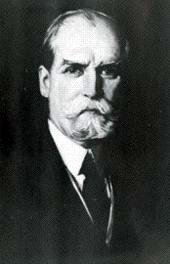Charles Evans Hughes
|
|
Charles Evans Hughes (April 11, 1862 – August 27, 1948) was a Governor of New York, a United States Secretary of State and Chief Justice of the United States.
Hughes was a precocious youngster. At age 6 he found public school boring and confining, submitted to his parents a plan of study for home schooling, which his parents accepted. Shortly before his 12th birthday, his family moved from Glens Falls, New York to New York City, where his parents enrolled him in public school, and he graduated from high school at age 13, second in his class.
He went to Madison College (now Colgate University) for two years, then transferred to Brown University, where he graduated in 1881 at age 19, youngest in his class, receiving third-highest honors. For the next year, he worked at Delaware Academy, in Delhi, New York where he taught Greek, Latin and algebra, in order to earn money to enter law school. He entered Columbia University law school in 1882, and graduated in 1884 with highest honors.
In 1885 he met Antoinette Carter, daughter of a senior partner of the law firm where he worked, and married her in 1888.
In 1891 he left the practice of law to become a professor at Cornell University Law School, but in 1893 he returned to his old law firm.
In 1905 he was appointed counsel to a New York state legislative committee investigating utility rates. He uncovered en=nd corruption to get gas rates lowered in New York City. As a result, he was appointed to investigate the insurance industry in New York.
Charles_Hughes_whistle_stop_1916.jpg
He served as Governor of New York from 1907–1910, defeating William Randolph Hearst in the 1906 election to gain the position, and being the only Republican statewide candidate to win office. In 1908 he was offered the vice-presidential nomination by William Howard Taft, but declined it to run again for Governor.
Subsequently he was appointed an Associate Justice of the Supreme Court, serving 1910–16, when he resigned to be Republican candidate for election as President of the United States (See U.S. presidential election, 1916). Defeated by Woodrow Wilson in a close election, he returned to private law practice. In 1920, Hughes favored the ratification of the treaty creating the League of Nations.
His next position in the United States government was Secretary of State under Warren G. Harding and Calvin Coolidge from 1921–1925. As Secretary of State, he called a conference in Washington, D.C. which produced a treaty on armament limitation. He did not, however, exert himself on behalf of the United States' adhering to the League of Nations during his service as Secretary of State. In the 1920s he served as a judge of the Permanent Court of Arbitration and the Permanent Court of International Justice in The Hague, The Netherlands. He was appointed Chief Justice of the United States by Herbert Hoover in 1930, serving until 1941. As Chief Justice, he led the fight against Franklin D. Roosevelt's attempt to pack the Supreme Court.
External links
- "Mr. Hughes Goes to War" (http://shwi.alternatehistory.com/Mr%20Hughes%20Goes%20to%20War.txt) (An alternate history where Hughes is elected President of the United States in 1916)
Archives
- Judge Manuscript Information: Charles Evans Hughes (http://air.fjc.gov/servlet/tGetMan?jid=1113). List of archives with documents via Judges of the United States Courts (http://air.fjc.gov/history/judges_frm.html). Retrieved April 15, 2005.
Legal opinions as Chief Justice
- NLRB v. Jones & Laughlin Steel Corp., 301 U.S. 1 (1937) (http://www.michaelariens.com/ConLaw/cases/joneslaughlin.htm).
- West Coast Hotel v. Parrish, 300 U.S. 379 (1937) (http://www.michaelariens.com/ConLaw/cases/westcoasthotel.htm)
| Preceded by: Frank W. Higgins | Governor of New York 1907–1910 | Succeeded by: Horace White |
| Preceded by: David Josiah Brewer | Associate Justice of the Supreme Court of the United States October 10, 1910–June 10, 1916 | Succeeded by: John Hessin Clarke |
| Preceded by: William Howard Taft | Republican Party Presidential candidate 1916 (lost) | Succeeded by: Warren G. Harding |
| Preceded by: Bainbridge Colby | United States Secretary of State 1921–1925 | Succeeded by: Frank B. Kellogg |
| Preceded by: William Howard Taft | Chief Justice of the United States February 24, 1930–June 30, 1941 | Succeeded by: Harlan Fiske Stone
|

